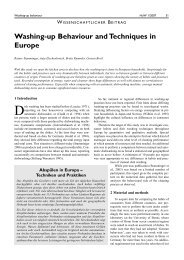Old Washing Machines Wash Less Efficiently and Consume More ...
Old Washing Machines Wash Less Efficiently and Consume More ...
Old Washing Machines Wash Less Efficiently and Consume More ...
You also want an ePaper? Increase the reach of your titles
YUMPU automatically turns print PDFs into web optimized ePapers that Google loves.
130 HuW 3/2005 Comparison Between <strong>Old</strong> <strong>and</strong> New <strong><strong>Wash</strong>ing</strong> Maschines<br />
W ISSENSCHAFTLICHER B EITRAG<br />
Figure 7: <strong><strong>Wash</strong>ing</strong> performance versus energy usage values for all machines under<br />
study (coded by year of production)<br />
Source: Own representation<br />
From left to right the energy values indicate the machines’ energy use for 40, 60 <strong>and</strong> 90 °C<br />
programmes; washing performance is given as index <strong>and</strong> corresponding class A to G as<br />
used by the European Energy Label. Error bars indicate st<strong>and</strong>ard deviation of index of washing<br />
performance <strong>and</strong> energy measured. Lines are for visualisation only<br />
Figure 8: Water usage <strong>and</strong> calculated energy usage for achieving class A performance by<br />
year of manufacture of washing machine.<br />
water in litre �<br />
160<br />
140<br />
120<br />
100<br />
80<br />
60<br />
40<br />
20<br />
0<br />
trend line energy<br />
used<br />
amount of water used (60 °C cotton programme)<br />
energy needed to achieve class A washing performance<br />
1970 1975 1980 1985 1990 1995 2000 2005 2010<br />
year of production �<br />
Source: Own representation<br />
Regression line y = er + ε (x - 1970) characteristics are with:<br />
y = energy in kWh or water in litre per cycle<br />
er = energy or water used in the reference year<br />
ε = annual improvement in energy or water usage<br />
x = year<br />
for water: ε = -3.16 l/a energy: ε = -0.061 kW h/a<br />
e r = 153.2 l e r = 2.73 kW h<br />
R² = 0.7204 R² = 0.7444<br />
trend line of water<br />
usage<br />
3.2<br />
2.8<br />
2.4<br />
2.0<br />
1.6<br />
1.2<br />
0.8<br />
0.4<br />
0.0<br />
By taking class A performance as<br />
a fixed level of required washing performance,<br />
it is possible to asses the<br />
efficiency of a washing machine, as<br />
the amount of energy used to achieve<br />
this level of performance. Although<br />
some linear extrapolations are needed<br />
in older machines, it becomes possible<br />
to compare the efficiency of different<br />
washing machines over time<br />
(Fig. 8). As expected, the efficiency<br />
values are distributed rather unevenly,<br />
but the general trend is that older<br />
machines require a much higher energy<br />
input than newer machines for the<br />
same washing performance. The trend<br />
line shows a much higher level of<br />
improvement compared to the comparison<br />
based on constant wash temperature<br />
(compared to Fig. 3). This is<br />
the influence of the improved washing<br />
performance. New machines use<br />
about half as much energy as 15-yearold<br />
machines <strong>and</strong> one fourth of the<br />
energy used by 30-year-old machines<br />
to reach the same washing<br />
energy in kWh �<br />
performance. A comparison<br />
of the amounts of water used<br />
for washing a fixed amount<br />
of load (Fig. 8) yields similar<br />
factors of improvement over<br />
time. Due to simple reasons,<br />
this trend can not continue<br />
forever.<br />
Assuming that a household<br />
washes five cycles per<br />
week in a new washing<br />
machine, its washing will<br />
consume about 80 v annually<br />
at average German rates for<br />
water (3.96 v/m³) (BGW<br />
2003a) <strong>and</strong> electricity<br />
(0.1719 v/kWh) (BGW<br />
2003b). Accordingly, a washing<br />
machine 15 years old<br />
would cost about twice as<br />
much (160 v/a) <strong>and</strong> one 30<br />
years old about four times as<br />
much (320 v/a) in annual running<br />
costs for water <strong>and</strong><br />
energy.





